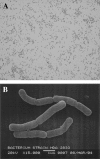Neisseria bacilliformis sp. nov. isolated from human infections
- PMID: 16455901
- PMCID: PMC1392657
- DOI: 10.1128/JCM.44.2.474-479.2006
Neisseria bacilliformis sp. nov. isolated from human infections
Abstract
Most Neisseria species are gram-negative cocci or diplococci; currently, N. elongata is the only species of human origin with a bacillary morphology. Here, we report isolation and characterization of eight strains of another bacillary Neisseria species from human infections. The organisms caused or contributed to either oral cavity-related or respiratory tract infections, and two strains were isolated from blood cultures. The 16S rRNA gene sequences of these organisms, being homogenous or nearly so (99.4 to 100% identity), matched at <96% known Neisseria species and formed a distinct group within the genus. Analysis of the cellular fatty acids showed broad similarity with a few Neisseria species. The organisms were gram negative and measured 0.6 mum by 1.3 to 3.0 mum. They grew well on chocolate agar and on sheep blood agar but did not grow on modified Thayer-Martin agar. They were positive for oxidase and negative for indole production. There was no acid production from dextrose, lactose, maltose, or sucrose. The tests for catalase reaction, nitrate reduction, and tributilin varied with the strains. These results suggest that these organisms represent a novel species within the genus Neisseria, for which the name Neisseria bacilliformis sp. nov. is proposed. The type strain is MDA2833 = ATCC BAA-1200(T) = CCUG50858(T). Distinction between N. bacilliformis and N. elongata can be made confidently by 16S rRNA gene sequencing or cellular fatty acid profiling but may be difficult by morphology or routine biochemical tests.
Figures


Similar articles
-
Neisseria wadsworthii sp. nov. and Neisseria shayeganii sp. nov., isolated from clinical specimens.Int J Syst Evol Microbiol. 2011 Jan;61(Pt 1):91-98. doi: 10.1099/ijs.0.022426-0. Epub 2010 Feb 19. Int J Syst Evol Microbiol. 2011. PMID: 20173010
-
Neisseria zalophi sp. nov., isolated from oral cavity of California sea lions (Zalophus californianus).Arch Microbiol. 2018 Jul;200(5):819-828. doi: 10.1007/s00203-018-1499-x. Epub 2018 Mar 5. Arch Microbiol. 2018. PMID: 29508031
-
Neisseria chenwenguii sp. nov. isolated from the rectal contents of a plateau pika (Ochotona curzoniae).Antonie Van Leeuwenhoek. 2019 Jul;112(7):1001-1010. doi: 10.1007/s10482-019-01234-2. Epub 2019 Feb 24. Antonie Van Leeuwenhoek. 2019. PMID: 30798492 Free PMC article.
-
Culture-negative infective endocarditis due to Neisseria bacilliformis identified via 16S rRNA gene analysis from resected valve tissue: Case report and review of the literature.J Infect Chemother. 2025 Feb;31(2):102502. doi: 10.1016/j.jiac.2024.08.017. Epub 2024 Aug 28. J Infect Chemother. 2025. PMID: 39214385 Review.
-
Neisseria elongata subsp. nitroreducens endocarditis in a seven-year-old boy.Pediatr Infect Dis J. 2005 Apr;24(4):391-2. doi: 10.1097/01.inf.0000157350.32886.ae. Pediatr Infect Dis J. 2005. PMID: 15818312 Review. No abstract available.
Cited by
-
Endocarditis caused by Neisseria bacilliformis: a case report and review of literature.IDCases. 2023 Feb 28;31:e01725. doi: 10.1016/j.idcr.2023.e01725. eCollection 2023. IDCases. 2023. PMID: 36923656 Free PMC article.
-
The class III ribonucleotide reductase from Neisseria bacilliformis can utilize thioredoxin as a reductant.Proc Natl Acad Sci U S A. 2014 Sep 9;111(36):E3756-65. doi: 10.1073/pnas.1414396111. Epub 2014 Aug 25. Proc Natl Acad Sci U S A. 2014. PMID: 25157154 Free PMC article.
-
Sigma factor RpoN (σ54) regulates pilE transcription in commensal Neisseria elongata.Mol Microbiol. 2013 Oct;90(1):103-13. doi: 10.1111/mmi.12350. Epub 2013 Aug 16. Mol Microbiol. 2013. PMID: 23899162 Free PMC article.
-
Evaluation of microbial load in oropharyngeal mucosa from tannery workers.Saf Health Work. 2015 Mar;6(1):62-70. doi: 10.1016/j.shaw.2014.09.003. Epub 2014 Oct 7. Saf Health Work. 2015. PMID: 25830072 Free PMC article.
-
Inhibitory effect of N-ethyl-3-amino-5-oxo-4-phenyl-2,5-dihydro-1H-pyrazole-1-carbothioamide on Haemophilus spp. planktonic or biofilm-forming cells.Med Chem Res. 2014;23(2):1057-1066. doi: 10.1007/s00044-013-0700-7. Epub 2013 Aug 23. Med Chem Res. 2014. PMID: 24465123 Free PMC article.
References
-
- Altschul, S. F., W. Gish, W. Miller, E. W. Myers, and D. J. Lipman. 1990. Basic local alignment search tool. J. Mol. Biol. 215:403-410. - PubMed
-
- Apisarnthanarak, A., W. C. Dunagan, and W. M. Dunne. 2001. Neisseria elongata subsp. elongata, as a cause of human endocarditis. Diagn. Microbiol. Infect. Dis. 39:265-266. - PubMed
-
- Bovre, K., and E. Holten. 1970. Neisseria elongata sp. nov., a rod-shaped member of the genus Neisseria. Re-evaluation of cell shape as a criterion in classification. J. Gen. Microbiol. 60:67-75. - PubMed
Publication types
MeSH terms
Substances
Associated data
- Actions
- Actions
- Actions
Grants and funding
LinkOut - more resources
Full Text Sources
Other Literature Sources
Molecular Biology Databases

